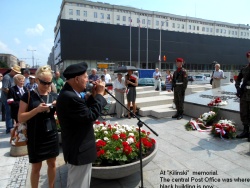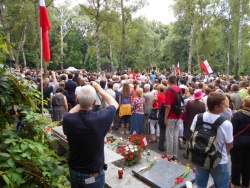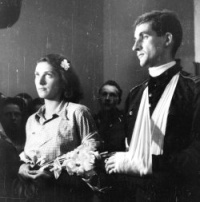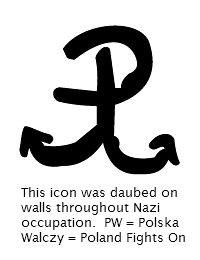

Commemoratuve events. ; A brief history. - click on pictures to enlarge
August 1. 2014, at 5 p.m., all traffic in Warsaw (and many other Polish cities), came to a standstill. Pedestrians stood silently for 70 seconds to honor the members of the underground Home Army (Armia Krajowa = AK) and the civilians who rose up 70 years ago against the Nazi invaders, and took over most of the city, in spite of lack of heavy weapons. Over 10,000 of the 40,000 insurgents. and over 150,000 civilians were killed (many in mass executions of civilians carried out by SS forces in the first days of the Uprising).
Thousands participated in the ceremonies of wreath laying - at the Grave of the Unknown Soldier - at the memorial to the Underground Polish State and AK - at the Powązki Miltary Cemetery - and many other memorials around the city.
The Uprising against Nazi occupiers lasted 63 days.
It failed because Stalin couldn't tolerate a free Polish force in Warsaw. Even Allied planes acarrying supplies to Warsaw were denied landing on Soviet airfields.
Recently opened documents revealed that, in spite of pleas of Churchill and the Polish government in London, president Roosevelt absolutely refused to pressure Stalin to assist the insurgents.
 In front of the Memorial Wall (inscribed with the names of Insurgents killed during the Uprising}, president Komorowski greeted the several hundred surviving veterans, many on crutches or in wheel chairs, who had come from as far as South Africa and Argentina to honor their comrades. He presented many with medals, including many who had helped maintain the traditions and built the Uprising Museum, such as the Museum Director Jan Ołdakowski.
In front of the Memorial Wall (inscribed with the names of Insurgents killed during the Uprising}, president Komorowski greeted the several hundred surviving veterans, many on crutches or in wheel chairs, who had come from as far as South Africa and Argentina to honor their comrades. He presented many with medals, including many who had helped maintain the traditions and built the Uprising Museum, such as the Museum Director Jan Ołdakowski. Veterans of Battalion "Kilinski" and their families laid wreaths at the memorial to the unit in Plac Powstanców (Insurgents' Square). Later many gathered for a luncheon at the top of the PAST building, which had been captured by the battalion after a long gruelling battle on 20 August 1944.
Veterans of Battalion "Kilinski" and their families laid wreaths at the memorial to the unit in Plac Powstanców (Insurgents' Square). Later many gathered for a luncheon at the top of the PAST building, which had been captured by the battalion after a long gruelling battle on 20 August 1944. All afternoon huge crowds started gathering at the military cemetery Powązki, to light torches and place flowers on the graves. Each major unit has its own quarter for graves of its members. The writer attended the "Kilinski" quarter. It is adjacent to the central black marble mounument Gloria Victis. This is where the Polish President (who is a relative of General " Bor"-Komorowski) - came to lay his wreath. At "W" hour, sirens sounded and all stood at attention in silence for 70 seconds, followed by a bugle call and three gun salute.
Friends told the writer that the crowds at the cemetery grow each year. Although veterans are dying off, children and grandchildren come in increasing numbers.
All afternoon huge crowds started gathering at the military cemetery Powązki, to light torches and place flowers on the graves. Each major unit has its own quarter for graves of its members. The writer attended the "Kilinski" quarter. It is adjacent to the central black marble mounument Gloria Victis. This is where the Polish President (who is a relative of General " Bor"-Komorowski) - came to lay his wreath. At "W" hour, sirens sounded and all stood at attention in silence for 70 seconds, followed by a bugle call and three gun salute.
Friends told the writer that the crowds at the cemetery grow each year. Although veterans are dying off, children and grandchildren come in increasing numbers.
 A team from Japanese TV was filming to prepare a special in Japanese about the Uprising.
A team from Japanese TV was filming to prepare a special in Japanese about the Uprising. During five years, members of the Polish resistance groups carried out a steadfast resistance to the German invaders, including sabotage and attacks on Nazi troops, particularly by partisans in the country and forests. For four years "underground" units had been training and establishing plans to attack German positions in the city. In July 1944, the Allies had established firm footholds in France and Italy and were steadily advancing. Soviet armies were advancing westward across Poland and by July 30 had reached eastern suburbs of Warsaw. Germans were retreating through the city. Soviet planes were bombing military targets in and around Warsaw. Soviet radio called on the Poles to rise up against the oppressors.
During five years, members of the Polish resistance groups carried out a steadfast resistance to the German invaders, including sabotage and attacks on Nazi troops, particularly by partisans in the country and forests. For four years "underground" units had been training and establishing plans to attack German positions in the city. In July 1944, the Allies had established firm footholds in France and Italy and were steadily advancing. Soviet armies were advancing westward across Poland and by July 30 had reached eastern suburbs of Warsaw. Germans were retreating through the city. Soviet planes were bombing military targets in and around Warsaw. Soviet radio called on the Poles to rise up against the oppressors.
The Home Army command designated 17:00 (5 p.m.) of August 1 as "W" hour.
Although lacking any heavy weapons, the approximately 20,000 strong Home Army units had most of the center city and three outlying areas under their control by the third day, capturing weapons and food supplies, with the Germans hanging on to many heavily armed strong points. Rail and road communications with the German front line on the eastern side of the river Vistula had been cut. Thousands joined the Home Army units, while thousands of civilian volunteers dug up paving stones building heavy anti-tank barricades. Others cooked for the troops and helped in any way they could. The power station was in Polish hands, water and electricity was available in the city center for three weeks. However the Soviet Army ceased all attacks, Soviet planes disappeared from the skies.
During the first 3 weeks, the Home Army had some successes, capturing the 11 story PAST building, the central railway station, the international telephone exchange and several other German positions, obtaining valuable supplies and prisoners. At the same time German armor drove a wedge separating the Old Town from the center and whittled away at the area held by the insurgents. Continuous aerial bombing, mortar fire and a railroad siege gun firing 1000kg shells flattened many buildings. SS units massacred 40,000 civilians in areas they regained, including patients and staff of two hospitals and nuns in a convent.
The Soviet Army resumed its offensive in September and reached the east bank of the river on September 13. They then halted and passively watched as across the river the Germans pounded away at us, pushing us back into three small areas, buildings reduced to smoking rubble. Finally the Germans recognized the Home Army as combatants under the Geneva Conventions and on October 2 the Home Army commander, general "Bor"-Komorowski surrendered. The surviving AK personnel were transported to P.O.W. camps already occupied by American, British and other Allied prisoners. The surviving civilian population dispersed into the country-side, except thousands of healthy persons were taken to Germany to work in factories and on farms.
The above is only a brief synopsis. For more complete information see:
http://en.wikipedia.org/wiki/Warsaw_Uprising
and
Personal accounts, newsreels, photos, songs.
Return to top of page.
Go to Biega photos taken at the ceremonies, be sure to click on the several links.
Photos taken at the 70th Uprising ceremonies,
60th Anniversary of Warsaw Upring
65th Anniversary of Warsaw Uprising in pictures.
Documentation of Warsaw Uprising.
Witness accounts, photos, videos, songs.
